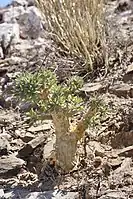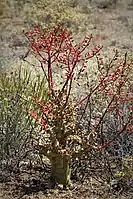| Tylecodon paniculatus | |
|---|---|
 | |
| Tylecodon paniculatus in Rooiberg Nature Reserve, South Africa. | |
| Scientific classification | |
| Kingdom: | Plantae |
| Clade: | Tracheophytes |
| Clade: | Angiosperms |
| Clade: | Eudicots |
| Order: | Saxifragales |
| Family: | Crassulaceae |
| Genus: | Tylecodon |
| Species: | T. paniculatus |
| Binomial name | |
| Tylecodon paniculatus | |
| Synonyms | |
| |
Tylecodon paniculatus, also known as butter bush, butter tree, butterboom or rooisuikerblom (Afrikaans), is a species of succulent plant in the genus Tylecodon belonging to the family Crassulaceae.[1]
Etymology
The genus name is a syllabic anagram of the former name Cotyledon, created by Helmut Toelken who split a few species off into a genus of their own.[2]
The species Latin epithet refers to the shape of inflorescence — branched terminal panicles.
The common names refer to soft, fleshy and brittle stems. For centuries children have used the soft, slippery stems as sleds.[3]
Description
Tylecodon paniculatus is a thickset, robust succulent dwarf tree up to 2.5–3 m tall, with very fat stems with usually well branched rounded crown. The single main trunk and branches are covered with mustard-yellow to olive-green bark peeling in papery semi-translucent sheets. Branches are short, with prominent leaf scars. Leaves are clustered and spirally arranged around the apex of the growing tips simple during the wintertime; they are paddle-shaped, 5–12 cm long and 2–10 cm wide, thickly succulent, bright yellowish-green; apex is broadly tapering to rounded, base is tapering without petiole. The plant is deciduous. Inflorescences are spectacular slender, ascending thyrses to 40 cm, with bright crimson-red stalks. Flowers have five joined sepals and five joined petals, forming an orange-yellow to red urn-shaped tube 1.5–2.5 cm long with spreading lobes. Ten stamens are pendulous at first, then upright as the petal-tube dries.[4][5]
Hybridises with Tylecodon wallichii.[6]
Habitat
Rocky slopes in Succulent Karoo.
Distribution
The species grows in the arid, winter rain-fall regions from Namibia to the southwestern South Africa.
Toxicity
The plant contains bufadienolide-type cardiac glycoside cotyledoside which causes cotyledonosis or nenta poisoning ("krimpsiekte") in sheep and goats.[7]
Subspecies
- Tylecodon paniculatus subsp. paniculatus — southwestern Namibia through to Cape Province.
- Tylecodon paniculatus subsp. glaucus van Jaarsv. — Namibia.[1]
Gallery
 Young plant in the early spring in Richtersveld.
Young plant in the early spring in Richtersveld. Flowering plant in ǀAi-ǀAis/Richtersveld Transfrontier Park.
Flowering plant in ǀAi-ǀAis/Richtersveld Transfrontier Park.
 Flowers in Anysberg Nature Reserve.
Flowers in Anysberg Nature Reserve.
References
- 1 2 "Tylecodon paniculatus (L.f.) Toelken". Plants of the World Online. Royal Botanic Gardens Kew. Retrieved 6 February 2022.
- ↑ Tölken, H. (15 December 1978). "New taxa and new combinations in Cotyledon and allied genera". Bothalia. 12 (3): 377–393. doi:10.4102/abc.v12i3.1794.
- ↑ Coates Palgrave, Keith (2002). Trees of southern Africa (3rd, New / rev. and updated by Meg Coates Palgrave ed.). Cape Town: Struik Publishers. p. 239. ISBN 1868723895.
- ↑ Eggli, Urs (2003). Illustrated Handbook of Succulent Plants: Crassulaceae. Berlin, Heidelberg: Springer Berlin Heidelberg. p. 359. ISBN 978-3-642-55874-0.
- ↑ F. Smith, Gideon; R Crouch, Neil; Figueiredo, Estrela (2017). Field Guide to Succulents of Southern Africa. Penguin Random House South Africa. p. 317. ISBN 9781775843672.
- ↑ Manning, John C.. (2013). Field guide to wild flowers of South Africa. Cape Town: Random House Struik. p. 236. ISBN 9781920544874.
- ↑ Kellerman, T. S.; Coetzer, J. A. W.; Naudé, T. W.; Botha, C. J. (2005). Plant poisonings and mycotoxicoses of livestock in southern Africa (2nd ed.). Oxford: Oxford University Press. pp. 116–146. ISBN 978-0195761344.
External links
 Media related to Tylecodon paniculatus at Wikimedia Commons
Media related to Tylecodon paniculatus at Wikimedia Commons- Bihrmann
- World of Succulents
